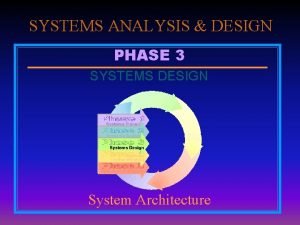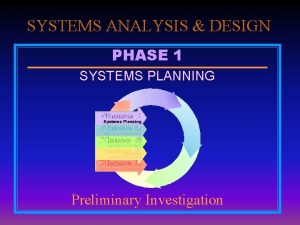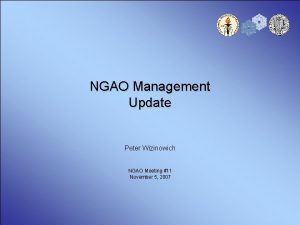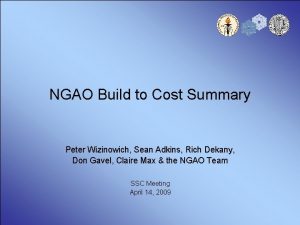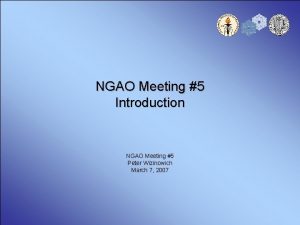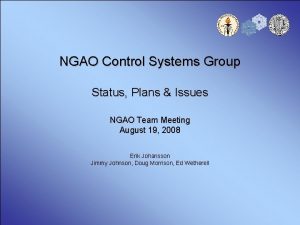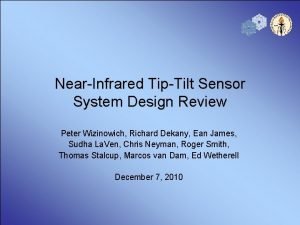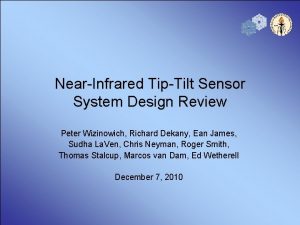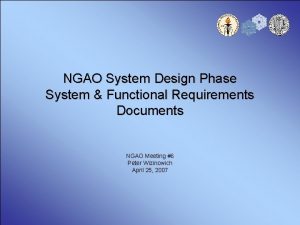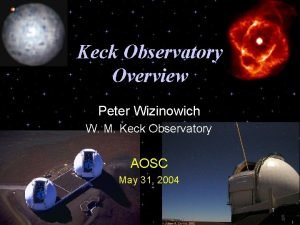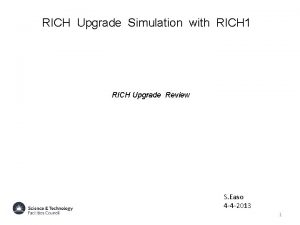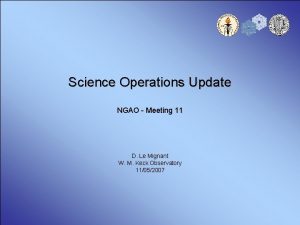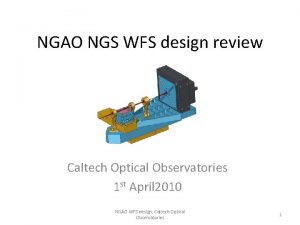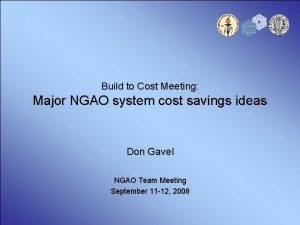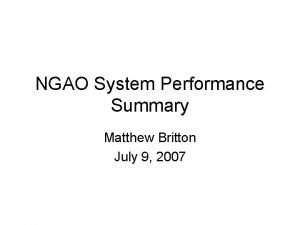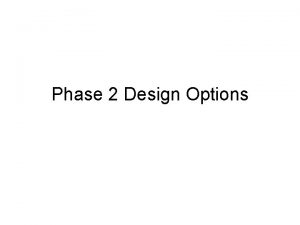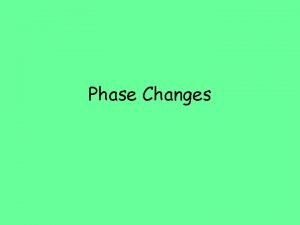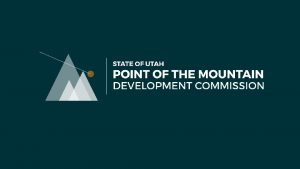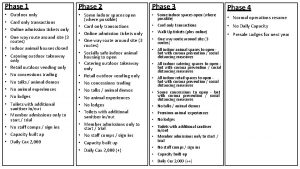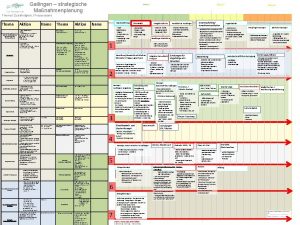NGAO System Design Phase Update Peter Wizinowich Rich






















- Slides: 22

NGAO System Design Phase Update Peter Wizinowich, Rich Dekany, Don Gavel, Claire Max for NGAO Team (with input from Sean Adkins, Matthew Britton, Ralf Flicker, Chris Neyman) SSC Meeting June 20, 2007

Presentation Sequence • Project Report #3 • Science & System Requirements • System Engineering – Performance Budgets – Trade Studies – System Architecture • Keck Science Meeting • Summary 2

Project Report #3

Project Report #3 • 3 rd report submitted to Directors on June 18 http: //www. oir. caltech. edu/twiki_oir/bin/view. cgi/Keck/NGAO/System. Design. Phase. Planning • Emphasis during this report period has been on: – Scheduled mid-year replan • – Science case & system requirements • • – Good progress on system requirements & significant work remains Postdoc, Elizabeth Mc. Grath, has started on a part-time basis Performance budgets & trade studies • • • – Replan complete & being tracked Astrometry & wavefront error reports issued Good progress on companion sensitivity 9 trade studies complete The definition and start of the system architecture phase • Priority task for this summer 4

Replan • Replan documents (v 26) posted at http: //www. oir. caltech. edu/twiki_oir/pub/Keck/NGAO/System. Design. Phase. Planning/ – KAON 481 System Design Phase Mid-FY 07 Replan – MS Project plan – Excel spreadsheet which records the changes • • Purpose to accomplish what we need for the system design phase within remaining budget & schedule. Endeavored to utilize lessons learned from the 1 st 6 months. – – • Descoped some activities not critical to system design Added some new activities that have been identified from our studies More encompassing system architecture phase introduced prior to subsystem designs Different management approach selected - using a small dedicated team with weekly telecons, for the 3 month system architecture phase. This phase will act as a test of this approach. In addition we will need to actively work with the team to bring tasks to closure 5

Project Report #3 – Status of New Milestone Dates # MILESTONE DATE STATUS 1 SD SEMP Approved 10/9/06 Complete 2 SD phase contracts in place 10/27/06 Complete 3 Science Requirements Summary v 1. 0 Release 10/27/06 Complete 4 System Requirements Document (SRD) v 1. 0 Release 12/8/06 Complete 5 Performance Budgets Summary v 1. 0 Release 6/15/07 25% complete 6 SRD v 2. 0 Release 5/22/07 Good progress 7 Trade Studies Complete 6/22/07 15 of 18 complete 8 SRD v 3. 0 Release 9/7/07 9 System Design Manual (SDM) v 1. 0 Release 9/21/07 10 Technical Risk Analysis V 1. 0 Release 11 Cost Review Complete 12/7/07 12 SDM v 2. 0 Release 2/12/08 13 System Design Review Package Distributed 3/4/08 14 System Design Review 3/31/08 15 SDR Report & Project Planning Presentation at SSC meeting 9/21/07 4/14/08 Some work as part of system architecture 9

Project Report #3 Schedule: 38% of System Design Phase activities complete through May Budget: $427. 5 k spent through May. – – 52% of the FY 07 budget (versus plan of ~67%) 41% of the System Design Phase budget, excluding contingency 10

Project Report #3 • Products since last report include the following KAONs: – 303 Mauna Kea Atmospheric Parameters – 471 Wavefront Error Budget – 474 Photometry for NGAO – 475 Tomography Codes Comparison and Validation for NGAO – 476 Observing Models Trade Study – 480 Astrometry for NGAO – 481 System Design Phase Mid-FY 07 Replan – 482 Keck Telescope Wavefront Error Trade Study – 483 Keck Interferometer Support Trade Study – 485 Adaptive Secondary Mirror Trade Study – 487 LOWFS Architecture Trade Study – 490 Rayleigh Rejection Trade Study – 492 Null-mode & Quadratic Mode Tomography Error – 493 Science Instrument Reuse Trade Study – 494 NGAO Project Report #3 All KAONs at http: //www. oir. caltech. edu/twiki_oir/bin/view. cgi/Keck/NGAO/New. KAONs 11

Science Case Requirements + Science Instruments

Science Case Requirements • Review of the science requirements section of the System Requirements Document (SRD) raised issues – Need to complete science requirements for each science case – Need to document flow down to performance requirements – Science Case Requirements Document (SCRD) v 1 missing several science cases – Need to better document science operations requirements & flow down • Next steps – Complete identification of performance requirements for AO & instruments – Work on “TBD” parameters identified in SRD – Complete science operations requirements section with identification of AO & instrument requirements – Complete SRD v 2 with goal values for performance requirements & initial sections for implementation & design requirements 13

Science Requirements: Improved Methodology • Cleaner separation between science-based requirements and derived requirements for AO + instruments • Example: Spectroscopy of galaxies lensed by galaxies (3 of 17 rows) • Better basis for evaluating AO trades (in process) 14

Science cases have been re-worked using new approach • “Science” parts of science requirements are clear • Flow-down to AO & instrument requirements in process • To date, no science case requires corrected fields larger than 15 - 20 arc sec • However, analysis of an additional science case is needed: resolved stellar populations – Trade-off between lower Strehl ratio over larger contiguous area (MCAO), vs. higher Strehl over multiple smaller areas (MOAO) • Until this is resolved, the system architecture study is carrying along one MCAO option 15

Science Case Requirements • The cases with initial science requirements tables include: – – – – – Asteroid companions survey and orbit determination Moons of the giant planets Shape and size of asteroids Galactic Center astrometry and radial velocities Planets around low mass stars High redshift galaxies Nearby AGNs Gravitational lensing QSO host galaxies • Galactic Center Nature of Sgr A*: 3 -5 µm color & 2 µm polarimetry was descoped as lower priority in the replan. • The science cases still requiring initial requirements tables include: – Debris disks, protostellar envelopes and outflows: contrast and polarimetry – Resolved stellar populations in crowded fields V 1. 10 of SRD: http: //www. oir. caltech. edu/twiki_oir/pub/Keck/NGAO/Work. Products/KAON 456_NGAO_SRD_v 1. 10. doc 16

Science Instruments (IWG) • Working on initial flow down from science requirements • Draft of “Summary Descriptions of NGAO Instruments” in progress • Next step is review of instrument function allocations and descriptions with science team 17

NGAO System Engineering: Performance Budgets Trade Studies System Architecture

Wavefront Error Budget Predictions Assumes a typical Mauna Kea turbulence profile with a Greenwood Frequency of 41 Hz Optimum system configuration depends on observing scenario Frame rates up to 2. 5 k. Hz Asterism diameters up to 1. 6 arcmin

Astrometric Precision Recommendations Astrometric accuracy/precision limited by imperfect PSF, optical distortion knowledge & refraction effects. Several tools could improve astrometry: • Cn 2 measurement on minute timescales – Baseline to understand stability expectations – Aid to target selection & observing strategy decisions – Profiles in post-processing algorithms for improving astrometry • Auxiliary PSF camera – To provide simultaneous OTF for use in post-processing – Nyquist sampled & deployable to find a PSF • Ability to solve for & monitor optical distortion in AO & instrument – Example: a well-machined pin hole slit mask far upstream in the optical path – Need to rotate & translate to solve for positions & optical distortions • Atmospheric dispersion corrector (ADC) – Could make identifying & correcting residual atmospheric refraction more difficult • • Provide plate scale stability at level of current Keck AO (<10− 4 over a night) Provide an adequate wavefront error – Preliminary: 140 nm required to achieve < 0. 1 mas 20

Trade Studies • The following studies have been completed since the last meeting: – – – – – MOAO & MCAO Adaptive secondary mirror option Keck Interferometer support Science instrument re-use Telescope wavefront errors Observing model Rayleigh rejection LGS wavefront sensor number and type Low order wavefront sensor architecture • Remaining studies: – Optical relay & field rotation strategy – D-IFU & LOWFS AO & object selection (new) – Uplink compensation (new) 21

LOWFS architecture Trade Study • Main conclusions: – Benefit from doing LOWFS in the NIR & combining J+H band • Consistent with KAON 470 – Pyramid overall performance better than Shack-Hartman (not significantly for tip-tilt) – NGS image sharpening is a performance driver: • Strongly suggests internal MEMS correction • Consider dedicated LGS for NGS sharpening • Tentative architecture recommendation: – Two near-IR tip/tilt WFS – One 2 x 2 pyramid WFS (tip/tilt, focus, astimatism) – All three have internal MEMS DMs 22

System Architecture • • • Focused “core” team (6 members) Builds on work to date (requirements, performance budgets & trade studies) 1 st define 2 -3 candidates for each of the key subsystems: – LGS production & control, optical relay, LGS & NGS wavefront sensing, acquisition – Example - LGS WFS evaluation includes: radial & conventional Shack-Hartman WFS & Pyramid WFS • • 2 nd evaluate these options for performance, risk & cost July 9 -13 UCSC meeting will focus on: – Candidate architectures as combinations of top ranked subsystems – Architecture system-level cost estimation – Initial subsystem functional requirements • http: //www. oir. caltech. edu/twiki_oir/bin/view. cgi/Keck/NGAO/System. Architecture 23

Keck Science Meeting • We would like to request part of the Keck Strategic Planning Meeting for NGAO – Entire morning or afternoon if possible • Goal – Broader community exposure, input & engagement • Suggested Topics – – Science cases & requirements System design overview Operational models Science instruments 24

Summary • Management: – Scheduled mid-year replan completed – Keeping on schedule will need close attention – Intention continues to be to deliver the system design within budget & schedule • Technical: – Good progress made on requirements, performance budgets & trade studies – System architecture phase begun 25
 Backup and recovery techniques
Backup and recovery techniques Rich and poor peter singer
Rich and poor peter singer Normal phase vs reverse phase chromatography
Normal phase vs reverse phase chromatography M tswett pronunciation
M tswett pronunciation Mobile phase and stationary phase
Mobile phase and stationary phase Chromatography means
Chromatography means Normal phase vs reverse phase chromatography
Normal phase vs reverse phase chromatography Phase to phase voltage
Phase to phase voltage Adsorption chromatography
Adsorption chromatography Phase to phase voltage
Phase to phase voltage Csce 441
Csce 441 Rich business system limited
Rich business system limited Are the rich happy questions and answers
Are the rich happy questions and answers This is the final task in phase 3: systems design
This is the final task in phase 3: systems design This is the final task in phase 3: systems design
This is the final task in phase 3: systems design For imperative statement 2 pass assembler
For imperative statement 2 pass assembler Channel design
Channel design This is the final task in phase 3: systems design.
This is the final task in phase 3: systems design. This is the final task in phase 3 systems design
This is the final task in phase 3 systems design Planning phase for network security design
Planning phase for network security design Types of output design
Types of output design User interface design in system analysis and design
User interface design in system analysis and design Dialogue design in system analysis and design
Dialogue design in system analysis and design













